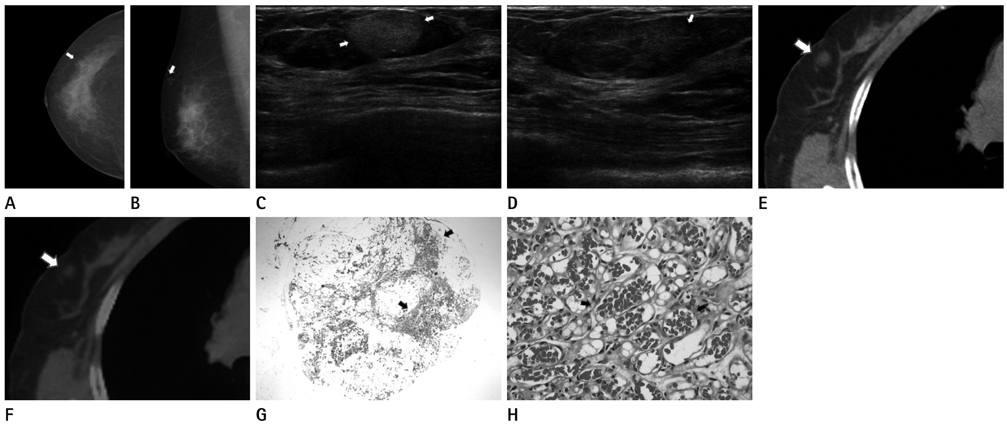J Korean Soc Radiol.
2013 Dec;69(6):475-479.
Subcutaneous Cavernous and Capillary Hemangiomas of the Breast: Radiologic-Pathological Correlation
- Affiliations
-
- 1Department of Radiology, Soonchunhyang University Cheonan Hospital, Cheonan, Korea. taloo@hanmail.net
- 2Department of Pathology, Soonchunhyang University Cheonan Hospital, Cheonan, Korea.
Abstract
- Vascular tumors of the breast are uncommon and include hemangioma, angiolipoma, and angiosarcoma. Among breast hemangiomas, capillary hemangiomas are relatively rare in contrast to cavernous hemangiomas. We report two rare cases of cavernous and capillary hemangiomas of the breast by mammography, sonography, and positron emission tomography/computed tomography.
MeSH Terms
Figure
Reference
-
1. Mesurolle B, Sygal V, Lalonde L, Lisbona A, Dufresne MP, Gagnon JH, et al. Sonographic and mammographic appearances of breast hemangioma. AJR Am J Roentgenol. 2008; 191:W17–W22.2. Siewert B, Jacobs T, Baum JK. Sonographic evaluation of subcutaneous hemangioma of the breast. AJR Am J Roentgenol. 2002; 178:1025–1027.3. Choi KH, Chang YW, Yang SB. Subcutaneous cavernous hemangioma of the breast: a case report. J Korean Radiol Soc. 2008; 59:209–211.4. Lee HB, Kim JY, Kim SH, Jeong MJ, Kim JH, Kim SH, et al. Cavernous hemangioma of the breast as a palpable mass: a case report. J Korean Soc Radiol. 2009; 60:207–209.5. Vieira SC, Silva JS, Madeira EB, França JCQ, Martins Filho SN. Breast hemangioma mimicking metastasis at PET-CT. Radiol Bras. 2011; 44:401–402.6. Hayasaka K, Tanaka Y, Saitoh T, Takahashi M. Gadolinium-enhanced dynamic MRI of breast hemangioma. Comput Med Imaging Graph. 2003; 27:493–495.7. Rosen PP, Jozefczyk MA, Boram LH. Vascular tumors of the breast. IV. The venous hemangioma. Am J Surg Pathol. 1985; 9:659–665.8. Schäfer FK, Biernath-Wuepping J, Eckmann-Scholz C, Order BM, Mathiak M, Hilpert F, et al. Rare Benign Entities of the Breast - Myoid Hamartoma and Capillary Hemangioma. Geburtsh Frauenheilk. 2012; 72:412–418.9. Rosen PP. Rosen's Breast Pathology. 3rd ed. Philadelphia: Lippincott Williams & Wilkins;2009. p. 789–797.10. Pui MH, Movson IJ. Fatty tissue breast lesions. Clin Imaging. 2003; 27:150–155.
- Full Text Links
- Actions
-
Cited
- CITED
-
- Close
- Share
- Similar articles
-
- Subcutaneous Cavernous Hemangioma of the Breast: A Case Report
- Immediate Breast Reconstruction after Resection of Cavernous Hemangioma
- Cavernous Hemangioma of the Breast as a Palpable Mass: A Case Report
- A Case of Cavernous Hemangioma Originated from the Middle Turbinate
- A Case of Subcutaneous Cavernous Hemangioma Presenting as a Nasolabial Fold Mass



